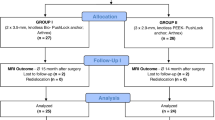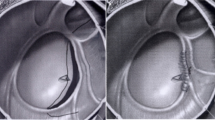Abstract
The Bankart lesion of the shoulder has long been associated with anterior instability. Our laboratory has developed a biomechanical model of the human shoulder which was used to determine the effects of creating a Bankart lesion on cadaveric specimens and then to compare the effects of two repair techniques. The model simulates the abducted, externally rotated position of the glenohumeral joint and uses pneumatic cylinders to simulate the rotator cuff forces. Specimens were tested intact following a partial Bankart lesion, following a complete Bankart lesion, and after performing a Bankart repair using three Mitek suture anchors. Finally, both the traditional and Mitek repairs were tested until failure. Strain in the inferior glenohumeral ligament (IGHL) and torque resistance was measured as an indication of instability of the joint. Strain was noted to decrease with increasing depth of lesion of the IGHL. Torsional rigidity of the shoulder decreased with increasing depth of lesion as well. Repairing the shoulder restores the strain and rigidity to control conditions. The mean load until failure was greater with the traditional repair than with the suture anchor technique. This study quantitates the effects of a Bankart lesion of the shoulder, and demonstrates that repairing the lesion with a suture anchor technique restores the biomechanics of the shoulder.
Similar content being viewed by others
References
Bankart ASB (1938) The pathology and treatment of recurrent dislocation of the shoulder joint. Br J Surg 26:23–29
Cain PR, Mutschler TA, Fu FH et al (1987) Anterior stability of the glenohumeral joint: a dynamic model. Am J Sports Med 15:144–148
Gowan ID, Jobe FW, Tibone JB et al (1987) A comparative electromyographic analysis of the shoulder during pitching. Am J Sports Med 15:586–590
Jarvholm U, Palmerud G, Herberts P et al (1989) Intramuscular pressure and electromyography in the supraspinatus muscle at shoulder abduction. Clin Orthop 245:102–109
Jarvholm U, Palmerud G, Karlsson D et al (1991) Intramuscular pressure and electromyography in four shoulder muscles. J Orthop Res 9:609–619
Klein AH, McKernan DJ, Harner CD (1989) A study of rotator cuff force vectors across the glenohumeral joint using magnetic resonance imaging. Trans Orthop Res Soc 14:230
Korner L, Parker P, Almstrom C et al (1984) Relation of intramuscular pressure to the force output and myoelectric signal of skeletal muscle. J Orthop Res 2:289–296
McKernan DJ, Mutschler TA, Rudert MJ et al (1989) Significance of a partial and full Bankart lesion: a biomechanical comparison. Trans Orthop Res Soc 35:231
O'Connell PW, Nuber GW, Ileski RA et al (1990) The contribution of the glenohumeral ligaments to anterior stability of the shoulder joint. Am J Sports Med 18:579–584
Ovesen J, Nielsen S (1985) Stability of the shoulder joint: cadaver study of stabilizing structures. Acta Orthop Scand 56: 149–151
Philipson L, Larsson PG (1988) The electromyographic signal as a measure ofmuscular force: a comparison of detection and quantification techniques. Electromyogr Clin Neurophysiol 28: 141–150
Ringelberg JA (1985) EMG and force production of some human shoulder muscles during isometric abduction. J Biomechanics 18:939–947
Rodosky MW, Rudert MJ, Harner CD et al. (1994) Significance of a superior labral lesion of the shoulder: a biomechanical study. Am J Sports Med 22:121–130
Terry GC, Hammon D, France PF et al (1991) The stabilizing function of passive shoulder restraints. Am J Sports Med 19: 26–34
Turkel SJ, Panio MW, Marshall JL et al (1981) Stabilizing mechanisms preventing anterior dislocation of the glenohumeral joints. JBJS 63A:1208–1217
Author information
Authors and Affiliations
Additional information
Investigation performed at the Albert B. Ferguson, Jr., MD Laboratory for Orthopaedic Research, University of Pittsburgh School of Medicine, Pittsburgh, Pennsylvania, USA
This work was supported by a grant from the Whitaker Foundation
Rights and permissions
About this article
Cite this article
Klein, A.H., Harner, C.D. & Fu, F.H. The Bankart lesion of the shoulder: A biomechanical analysis following repair. Knee Surg, Sports traumatol, Arthroscopy 3, 117–120 (1995). https://doi.org/10.1007/BF01552387
Issue Date:
DOI: https://doi.org/10.1007/BF01552387




